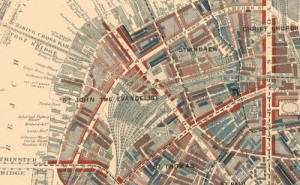Waterloo Bridge Rd. was the combined Waterloo Bridge and Waterloo Street. The road mentioned in “Man With A Twisted Lip” which turns into Wellington Street is Waterloo Bridge Road. “The formation of Waterloo Bridge—which was  completed and opened on the 18th of June, 1817—as may be expected, soon made a great alteration in the appearance of Southern London, especially in those parts lying between Blackfriars and Westminster Bridge Roads” (Lambeth). Its name commemorates the victory of the British, the Dutch and the Prussians at the Battle of Waterloo in 1815. The approaching road and other various areas of London also share the name Waterloo in respect and honor.
completed and opened on the 18th of June, 1817—as may be expected, soon made a great alteration in the appearance of Southern London, especially in those parts lying between Blackfriars and Westminster Bridge Roads” (Lambeth). Its name commemorates the victory of the British, the Dutch and the Prussians at the Battle of Waterloo in 1815. The approaching road and other various areas of London also share the name Waterloo in respect and honor.
The area was mostly middle class, at least on the main street. Waterloo Bridge Road was part of the parishes of St Andrew, St John, St Thomas [Lambeth]and Christ Churc h (Charles Booth). Most of the crime committed in the area was theft and a handful of highway robberies that may have ended on the bridge itself. Overall the information on Waterloo Bridge Road is scarce. Most of it is about the surrounding area, the bridge and its southern approach have little influence to the surrounding areas.
h (Charles Booth). Most of the crime committed in the area was theft and a handful of highway robberies that may have ended on the bridge itself. Overall the information on Waterloo Bridge Road is scarce. Most of it is about the surrounding area, the bridge and its southern approach have little influence to the surrounding areas.
Even in “Man With A Twisted Lip” the Road is but a way across the river. “Passing down the Waterloo Bridge Road we crossed over the river, and dashing up Wellington Street…”(Doyle). The river divides London, it also helps divide class. This can be seen in the story as crossing the water is linked to crossing classes and lifestyles. This crossing of the bridge represents the crossing of themes in the story.
Waterloo Bridge Road is the southern approach to Waterloo Bridge. The Bridge approach was built on a piece of ground which for many years was part of Cuper’s (or Cupid’s) Garden. The road
“One of the earliest buildings in Waterloo Road was the Royal Universal Infirmary for Children. This institution was the successor of the Universal Dispensary for Sick and Indigent Children founded in 1816… The infirmary was built on land which was part of the triangular slip of ground bought by the Waterloo Bridge Company from Jesus College, Oxford, and assigned to the Duchy of Cornwall in exchange for ground given up to form the bridge approaches.”(Waterloo Road).
Works Cited
“Charles Booth Online Archive.” Search Survey Notebook Pages (Charles Booth Online Archive). Web. 16 Oct. 2015.
Doyle, Arthur Conan. The Man with the Twisted Lip. N.p.: n.p., n.d. Print.
“Lambeth: Waterloo Road.” Lambeth: Waterloo Road. Web. 16 Oct. 2015.
‘Waterloo Road.’ Survey of London: Volume 23, Lambeth: South Bank and Vauxhall. Ed. Howard Roberts and Walter H Godfrey. London: London County Council, 1951. 25-31. British History Online. Web. 14 October 2015. http://www.british-history.ac.uk/survey-london/vol23/pp25-31.
